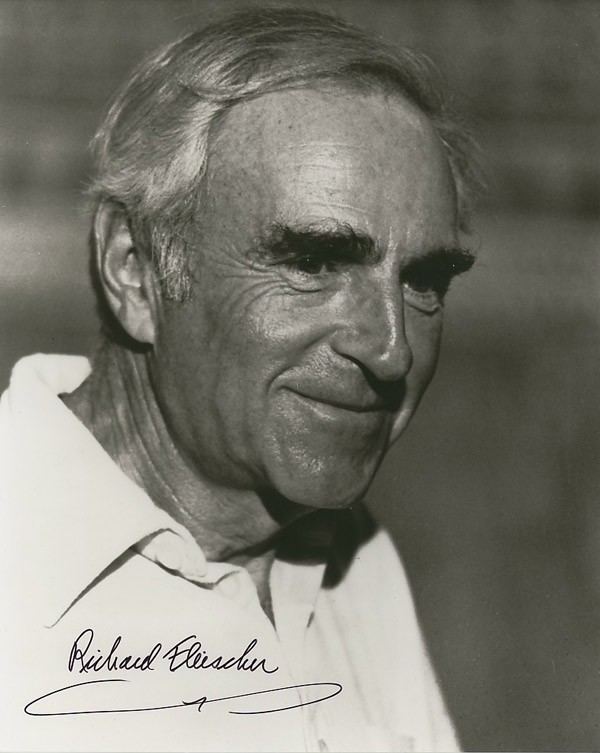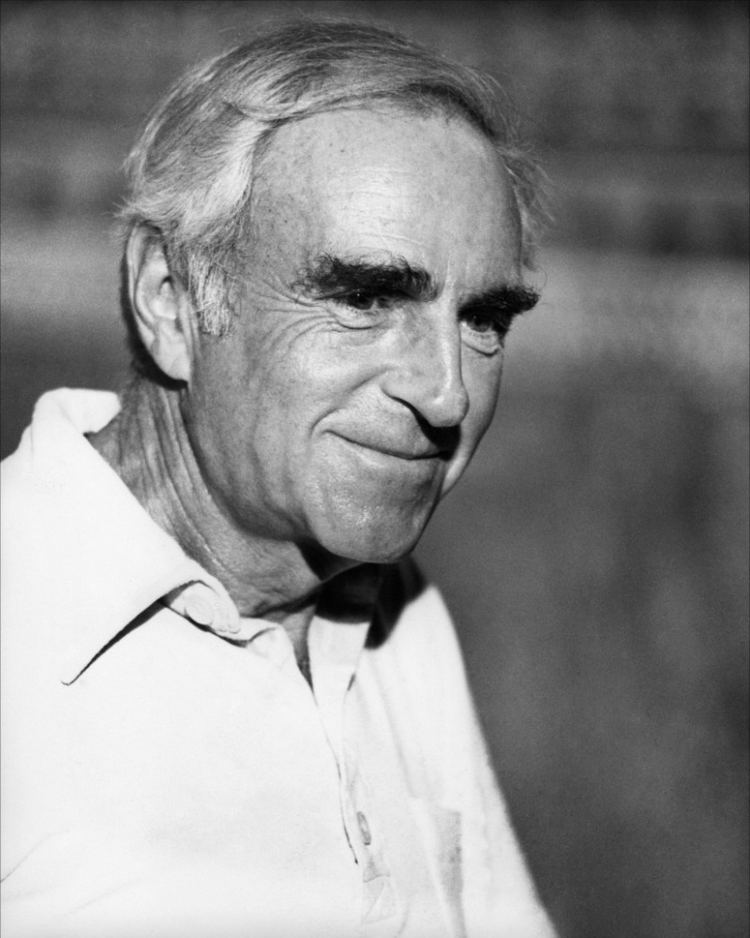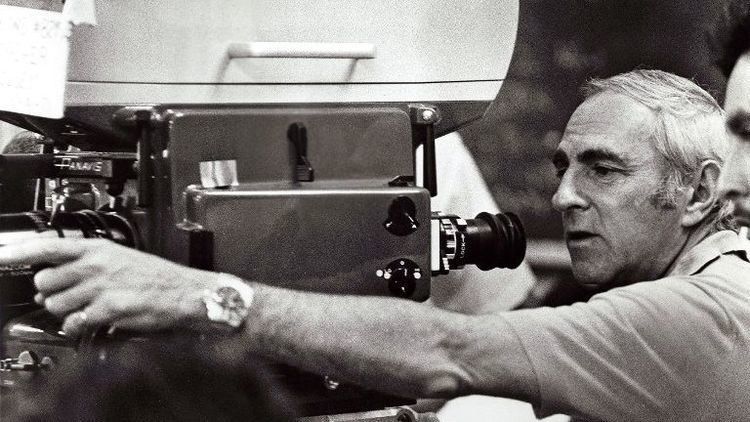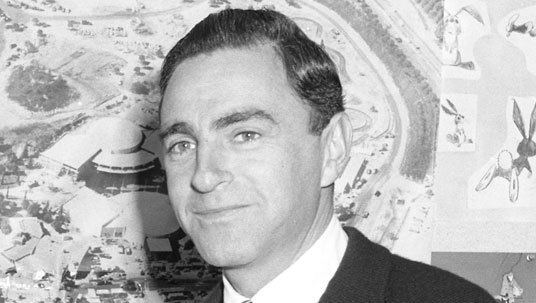Occupation Film director Years active 1943–1987 | Name Richard Fleischer Role Film director | |
 | ||
Died March 25, 2006, Woodland Hills, California, United States Spouse Mary Dickson (m. 1943–2006) Books Just tell me when to cry, Out Of The Inkwell Children Bruce Fleischer, Mark Fleischer, Jane Fleischer Reid Movies Soylent Green, Fantastic Voyage, Conan the Destroyer, The Vikings, 20 - 000 Leagues Under the Similar People | ||
Narrow margin 1952 film noir richard fleischer s outlook
Richard O. Fleischer (December 8, 1916 – March 25, 2006) was an American film director, best known for Soylent Green (1973).
Contents
- Narrow margin 1952 film noir richard fleischer s outlook
- Richard fleischer highest grossing movies
- Early life
- RKO B Movies
- Kramer Company
- A Picture Director
- 20th Century Fox
- Europe
- Return to Hollywood
- Seventies Films
- Later career
- Death and legacy
- Filmography
- Accolades
- References

Richard fleischer highest grossing movies
Early life

Fleischer was born in Brooklyn, the son of Essie (née Goldstein) and animator/producer Max Fleischer. After graduating from Brown University, he went to Yale School of Drama, where he met his future wife, Mary Dickson.

His film career began in 1942 at the RKO studio, directing shorts, documentaries, and compilations of forgotten silent features, which he called "Flicker Flashbacks". He won an Academy Award as producer of the 1947 documentary Design for Death, co-written by Theodor Geisel (later known as Dr. Seuss), which examined the cultural forces that led to Japan's imperial expansion through World War II.
RKO B Movies

Fleischer moved to Los Angeles and was assigned his first feature, Child of Divorce (1946), a vehicle for Sharyn Moffett. It was successful so Fleischer was assigned to another Moffett vehicle, Banjo, which was a disaster.

RKO agreed to loan him out to Stanley Kramer and Carl Foreman, who had admired Child of Divorce, to make So This Is New York (1948) for the Kramer Company at Columbia. Back at RKO Fleischer made a thriller based on a story by Foreman, The Clay Pigeon.
His other early films were taut film noir thrillers such as Bodyguard (1948), Follow Me Quietly (1949), Armored Car Robbery (1950), and The Narrow Margin (1952).
Fleischer says he constantly tried to graduate to A pictures during this time. When Norman Krasna and Jerry Wald set up at RKO, they asked Fleischer to see if he could make a film out of any of the film shot for It's All True but he was unable to. Another project that did not come to fruition was a film starring Al Jolson.
RKO's owner, Howard Hughes, was impressed by The Narrow Margin and hired Fleischer to re-shoot portions of His Kind of Woman (1952). Hughes was pleased with the results and agreed to loan out Fleischer to Stanley Kramer to make The Happy Time (1952).
Kramer Company
Fleischer was put under contract to the Kramer Company. The Happy Time was successful and Fleischer was meant to follow it with another for Kramer and Foreman, Full of Life. However the film was never made because the partnership between Foreman and Kramer ended.
He accepted an offer from MGM to make Arena, a rodeo-themed story starring Gig Young and Jean Hagen.
A Picture Director
In 1954, he was chosen by Walt Disney (his father's former rival as a cartoon producer) to direct 20,000 Leagues Under the Sea starring Kirk Douglas, James Mason, Paul Lukas, and Peter Lorre. While doing post production for the film, Fleischer received an offer from Dore Schary at MGM to direct Bad Day at Black Rock but had to turn it down because of all the post production work still required on Leagues.
He was able to accept an offer to direct a thriller for Buddy Adler at 20th Century Fox, Violent Saturday (1955). This was successful and Fox signed Fleischer to a long term contract. He would work for that studio for the next fifteen years.
20th Century Fox
Fleischer's first film under his new contract with Fox was The Girl in the Red Velvet Swing (1955). He then made Bandido, a Western with Robert Mitchum.
Kirk Douglas hired Fleischer to make The Vikings (1958), which was another big hit. Back at Fox, Fleischer made Compulsion (1959), a crime drama with Orson Welles for producer Richard D. Zanuck. It was successful and earned Fleischer a Directors Guild Award nomination.
Europe
Fox offered him a movie with John Wayne, North to Alaska which Fleischer originally agreed to do, but pulled out of when he was unhappy with the script. He moved to Paris where Darryl F. Zanuck asked him to make The Ballad of Red Rocks, a vehicle for Zanuck's then-girlfriend Juliette Greco. The film was not made but Fleischer instead directed two other stories for Zanuck starring Greco, Crack in the Mirror (1960) and The Big Gamble (1961).
Fleischer then signed a contract with Dino de Laurentiis to make Barabbas (1962). After that, he and de Laurentiis announced a series of projects, including Lanny Budd (from a novel by Upton Sinclair), Don Camillo, Salvatore Guliano, Dark Angel and Sacco and Vanzetti (from a script by Edward Anhalt), but none were made.
He accepted an offer from Samuel Bronston and Philip Yordan to make The Nightrunners of Bengal in Spain but that project fell apart when Bronston's empire collapsed.
Return to Hollywood
Back in Hollywood, Richard Zanuck had become head of production at Fox and offered Fleischer Fantastic Voyage (1966). It was a success and resurrected his Hollywood career.
He was entrusted with Fox's big "roadshow" musical of 1967, Doctor Dolittle (1967), with Rex Harrison. It was popular but failed to recoup its enormous cost. Most acclaimed was The Boston Strangler (1968), with Tony Curtis.
Che! (1969), a biopic of Che Guevera that starred Omar Sharif, was an expensive flop, as was an account of the attack on Pearl Harbor, Tora! Tora! Tora! (1970). This was his last film for 20th Century Fox.
Seventies Films
Fleischer travelled to England, where he directed an acclaimed thriller, 10 Rillington Place (1971) starring Richard Attenborough. He then replaced John Huston, who had fallen out with star George C Scott, on The Last Run (1971).
See No Evil (1971) with Mia Farrow was another thriller. In Hollywood, he made The New Centurions (1972) from the novel by Joseph Wambaugh, again starring George C. Scott.
At MGM, he made a science-fiction film, Soylent Green (1973), with Charlton Heston. Action films followed: The Don Is Dead (1973), with Anthony Quinn, plus two for Walter Mirisch: The Spikes Gang (1974), with Lee Marvin and Mr. Majestyk (1974), with Charles Bronson, written by Elmore Leonard.
He was reunited with De Laurentiis for the popular, if controversial, Mandingo (1975). The Incredible Sarah (1976) was a British biopic of Sarah Bernhardt with Glenda Jackson.
The Prince and the Pauper (1977) was a version of the Mark Twain novel that featured Heston, Harrison and Scott in its cast. Fleischer was then hired to replace Richard Sarafian on Ashanti (1979), starring Michael Caine, which turned out to be a flop. He received another call to replace a director, in this case Sidney J. Furie, on The Jazz Singer (1980), an unsuccessful attempt to make a film star out of Neil Diamond.
Later career
Tough Enough (1983) was about the Toughman Contest starring Dennis Quaid. He made three more for de Laurentiis, Amityville 3-D (1983), Conan the Destroyer (1984) and Red Sonja (1985).
His final theatrical feature was Million Dollar Mystery (1987).
Later career
Fleischer was chairman of Fleischer Studios, which today handles the licensing of Betty Boop and Koko the Clown. In June 2005, he released his memoirs of his father's career in Out of the Inkwell: Max Fleischer and the Animation Revolution.
Death and legacy
He died in his sleep at age 89, after having been in failing health for the better part of a year.
Fleischer's 1993 autobiography, Just Tell Me When to Cry, described his many difficulties with actors, writers and producers.
Japanese film director Kiyoshi Kurosawa expresses admiration for Fleischer.
Filmography
Source:
Accolades
Wins
Nominations
Unsolicited nomination
